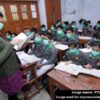The enigma of online education – a student’s view
 – Abhimanyu J. Kumar, class XII student, Vasant Valley School, Delhi
– Abhimanyu J. Kumar, class XII student, Vasant Valley School, Delhi
The world woke up to an unprecedented situation in March of 2020 with the global Coronavirus pandemic generating a crisis that forced the closure of all schools countrywide. Little did anybody know at that time that our world of learning would change forever. For most of us used to attending school on campus, we took it for granted that we would be able to go to school and learn every day, meet our friends, enjoy the conversations during class breaks, over lunches, play sports and learn from our teachers and peers. I never imagined that I would be sitting in front of computers all day long, not just playing video games or watching movies, but attending classes, exams and engaging in tutorial sessions with my teachers.
What’s good about online education. The most important thing about online education is that some of us are privileged to access it. At the peak of the pandemic as per UNESCO data, over 1.6 billion learners in more than 190 countries of the world were totally out of school, and over 100 million teachers and school employees were impacted by the sudden closure of educational institutions. Today, half of the world’s student population (more than 800 million) is adversely affected by full or partial school closures. In 29 countries, schools remain fully closed. This data itself shows how privileged we are to access online education. Another advantage of online education is the degree of democratisation of education with learners in remotest parts of India being able to use technology to access education. This is a very big aspect of inclusion that is central to education. While electricity, Internet connection and good equipment are essential for online education, it does provide an opportunity for many children who would have been deprived of it during the pandemic to be able to access education.
What’s bad about online education. The biggest challenge of online education is its inherent limitation for creating an inspiring learning ecosystem. It is very difficult to replicate classroom dynamics and live experiences of schooling in a virtual environment. What I have also realised in the past year is that classroom experiences, corridor conversations, the idleness of breaks and co-curricular and extra-curricular learning that happens outside classrooms is equally important.
There is so much that happens in a school that cannot be emulated – despite the best efforts of teachers – by online learning. It is very difficult to sustain the intellectual curiosity of children for long periods of time through online education. Opportunities to meet with friends, play sports and games and develop a sense of community are missing. This has the potential to cause mental health problems for children.
Making the best of the situation. Even though some of us are privileged to receive online education, we want more. The on-campus learning experience in its fullest form is some time away and so long as the vaccine for school children remains elusive, fear of the Covid virus will dominate discussions related to reopening schools. All of us students, teachers and parents have responsibilities and are going through difficult times. Our generation will have many stories to tell, but the most important one will be the story of our resilience and adaptability to overcome this unprecedented crisis. This experience with all its challenges will surely stand us in good stead in the future.
The future and the world ahead. There is a future for online education and virtual learning. But for that to become a reality, we need to do more. According to Unesco, half the world’s population (some 3.6 billion people) still lack Internet connectivity. Therefore, an estimated 463 million or nearly one-third of students worldwide cannot access remote learning. According to UN estimates, “…nearly 500 million students from pre-primary to upper-secondary school did not have any access to any remote learning – three-quarters of them live in the poorest households or rural areas. This enormous digital divide shows how connectivity has become a key factor to guarantee the right to education. Digital skills and learning must be incorporated into education systems in order to address the injustice of the digital divide”.
As we move into the post-pandemic age, we need to harness the learning of the past 18 months. All stakeholders in education – teachers, parents and students — must learn to appreciate the importance of friendships, relationships, family in addition to the value of education and mentoring. Everything that took for granted before the pandemic will become more special and more important and these lived moments of adversity will become memories and learning experiences. The future may be uncertain, but we are better prepared to confront its challenges.






 – Abhimanyu J. Kumar, class XII student,
– Abhimanyu J. Kumar, class XII student, 










Add comment